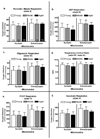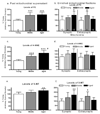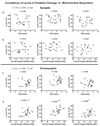Age-related changes in mitochondrial respiration and oxidative damage in the cerebral cortex of the Fischer 344 rat
- PMID: 20080122
- PMCID: PMC2834189
- DOI: 10.1016/j.mad.2009.12.011
Age-related changes in mitochondrial respiration and oxidative damage in the cerebral cortex of the Fischer 344 rat
Abstract
This study probed possible age-related changes in mitochondrial bioenergetics in naïve Fischer 344 rats. Synaptic and extrasynaptic mitochondria were isolated from the cortex of one hemisphere of young (3-5 months), middle (12-14 months), or aged (22-24 months) rats. Respiration parameters were obtained using a Clarke-type electrode. Aged rats displayed no significant alterations in respiration, indicating mitochondria must be more resilient to the aging process than previously thought. Synaptic mitochondria displayed lower respiration capacities than the extrasynaptic fraction. Aged F344 rats appear capable of normal electron transport chain function without declines in ability to produce ATP. Markers of cortical oxidative damage (3-nitrotyrosine [3-NT], 4-hydroxynonenal [4-HNE], and protein carbonyls [PC]) were collected from the post-mitochondrial supernatant (PMS) from the contralateral hemisphere, and from mitochondrial samples following respiration analysis. Age-related increases in PC and 3-NT levels were found in synaptic mitochondria, whereas significant extrasynaptic elevations were only found in middle aged rats. These findings support an age-related increase in oxidative damage in the cortex, while proposing the two fractions of mitochondria are differentially affected by the aging process. Levels of oxidative damage that accumulates in the cortex with age does not appear to significantly impair cortical mitochondrial respiration of F344 rats.
2010 Elsevier Ireland Ltd. All rights reserved.
Conflict of interest statement
The authors have no conflict of interest.
Figures





Similar articles
-
Age-related mitochondrial changes after traumatic brain injury.J Neurotrauma. 2010 May;27(5):939-50. doi: 10.1089/neu.2009.1181. J Neurotrauma. 2010. PMID: 20175672 Free PMC article.
-
Brain cortex mitochondrial bioenergetics in synaptosomes and non-synaptic mitochondria during aging.Neurochem Res. 2016 Feb;41(1-2):353-63. doi: 10.1007/s11064-015-1817-5. Epub 2016 Jan 28. Neurochem Res. 2016. PMID: 26818758
-
The Effect of Aging on Mitochondrial Complex I and the Extent of Oxidative Stress in the Rat Brain Cortex.Neurochem Res. 2016 Aug;41(8):2160-72. doi: 10.1007/s11064-016-1931-z. Epub 2016 May 9. Neurochem Res. 2016. PMID: 27161369
-
Protective effects of phenelzine administration on synaptic and non-synaptic cortical mitochondrial function and lipid peroxidation-mediated oxidative damage following TBI in young adult male rats.Exp Neurol. 2020 Aug;330:113322. doi: 10.1016/j.expneurol.2020.113322. Epub 2020 Apr 20. Exp Neurol. 2020. PMID: 32325157 Free PMC article. Review.
-
Oxidative stress in human aging and mitochondrial disease-consequences of defective mitochondrial respiration and impaired antioxidant enzyme system.Chin J Physiol. 2001 Mar 31;44(1):1-11. Chin J Physiol. 2001. PMID: 11403514 Review.
Cited by
-
Mitral and tufted cells are potential cellular targets of nitration in the olfactory bulb of aged mice.PLoS One. 2013;8(3):e59673. doi: 10.1371/journal.pone.0059673. Epub 2013 Mar 18. PLoS One. 2013. PMID: 23527248 Free PMC article.
-
ROS networks: designs, aging, Parkinson's disease and precision therapies.NPJ Syst Biol Appl. 2020 Oct 26;6(1):34. doi: 10.1038/s41540-020-00150-w. NPJ Syst Biol Appl. 2020. PMID: 33106503 Free PMC article.
-
Involvement of redox state in the aging of Drosophila melanogaster.Antioxid Redox Signal. 2013 Sep 10;19(8):788-803. doi: 10.1089/ars.2012.5002. Epub 2013 Apr 6. Antioxid Redox Signal. 2013. PMID: 23458359 Free PMC article. Review.
-
From mitochondrial dysfunction to amyloid beta formation: novel insights into the pathogenesis of Alzheimer's disease.Mol Neurobiol. 2012 Aug;46(1):186-93. doi: 10.1007/s12035-012-8307-4. Epub 2012 Jul 26. Mol Neurobiol. 2012. PMID: 22833458 Review.
-
Mitochondrial dysfunction precedes hippocampal IL-1β transcription and cognitive impairments after low-dose lipopolysaccharide injection in aged mice.Heliyon. 2024 Mar 30;10(7):e28974. doi: 10.1016/j.heliyon.2024.e28974. eCollection 2024 Apr 15. Heliyon. 2024. PMID: 38596096 Free PMC article.
References
-
- Ames BN, Shigenaga MK, et al. Mitochondrial decay in aging. Biochim Biophys Acta. 1995;1271(1):165–170. - PubMed
-
- Ansari MA, Roberts KN, et al. A time course of contusion-induced oxidative stress and synaptic proteins in cortex in a rat model of TBI. J Neurotrauma. 2008;25(5):513–526. - PubMed
-
- Armeni T, Principato G, et al. Mitochondrial dysfunctions during aging: vitamin E deficiency or caloric restriction--two different ways of modulating stress. J Bioenerg Biomembr. 2003;35(2):181–191. - PubMed
-
- Atamna H, Frey WH., 2nd Mechanisms of mitochondrial dysfunction and energy deficiency in Alzheimer's disease. Mitochondrion. 2007;7(5):297–310. - PubMed
-
- Baek BS, Kwon HJ, et al. Regional difference of ROS generation, lipid peroxidation, and antioxidant enzyme activity in rat brain and their dietary modulation. Arch Pharm Res. 1999;22(4):361–366. - PubMed
Publication types
MeSH terms
Grants and funding
LinkOut - more resources
Full Text Sources
Medical
Research Materials

